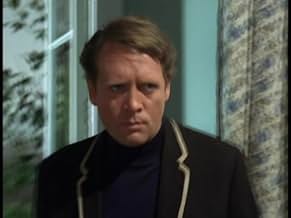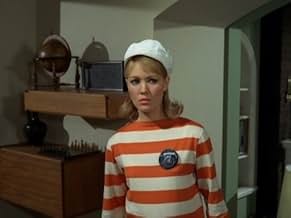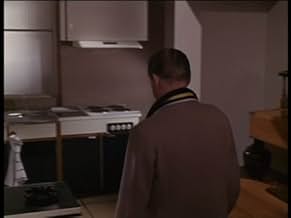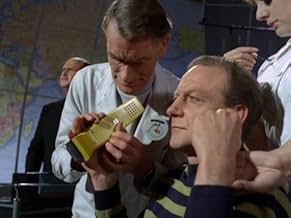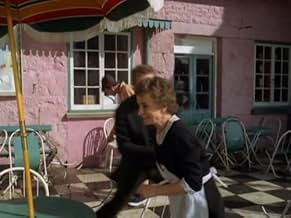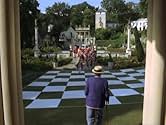Dopo le dimissioni, un agente segreto viene rapito e portato in quello che sembra un villaggio idilliaco, ma è davvero una prigione bizzarra.Dopo le dimissioni, un agente segreto viene rapito e portato in quello che sembra un villaggio idilliaco, ma è davvero una prigione bizzarra.Dopo le dimissioni, un agente segreto viene rapito e portato in quello che sembra un villaggio idilliaco, ma è davvero una prigione bizzarra.
- Premi
- 1 vittoria e 1 candidatura in totale
Sfoglia gli episodi
Recensioni in evidenza
When I saw the first episode of this series, my jaw dropped in amazement. Here was a TV series that was entertaining and actually made you think. Nothing was ever what it appeared, no one had a real name, you never knew who was the good guy or the bad guy (or if they were one in the same!). The "final" episode was what could only be described as PSYCHEDELIC.
This TV series was, and still is, way ahead of its time.
As a side note, there is a "lost" first episode that is wildly different than the first one generally aired that explains some of the symbolism used in the series.
I hope the movie remake is made and distributed.
This TV series was, and still is, way ahead of its time.
As a side note, there is a "lost" first episode that is wildly different than the first one generally aired that explains some of the symbolism used in the series.
I hope the movie remake is made and distributed.
'The Prisoner' is one of those things that inspires either absolute devotion or utter confusion. There are no halfway reactions to this TV series. Many consider it to be the most imaginative and original TV show ever, and I'm inclined to agree with them. Nothing until 'Twin Peaks' came close to competing with it. However unlike 'Twin Peaks', 'The Prisoner' knew when to stop. There is hardly a bad episode in the whole series, and the final show is perfect. Patrick McGoohan will always have an important place in not only television history, but pop culture as a whole, from his involvement with this stunning and unforgettable show. To me it gets better and better as the years go by. If you haven't ever seen it make sure you do so! You don't know what you're missing!
Unfortunately, when you see see The Prisoner for the first time at an early age it tends to spoil television for the rest of your life. I was thirteen when I saw it in 1968, and for more than thirty years I keep hoping to find TV shows (and movies and books) that will give me the same rush of seeing vast, unexpected and unexplained vistas for the very first time. Too, too rare. Virtually non-existent. For The Prisoner didn't just present a new 'twist' (rare enough), it was a whole new world, with a wildly different culture, environment and rules, only gradually comprehended, if at all. And yet, strangely, it is more like the "real" world than any other television program, even the news, because The Prisoner doesn't explain itself, it just happens. If YOU want to know what's going on, figure it out for yourself... if you can. You might be right, you might be wrong, but if simplistic explanations are your comfort, you almost certainly WILL be wrong. Just like explorers of old. Just like real life. Though with the increasing homogenization of the world, real life is becoming, alas, more like television.
When it premiered in the US as a CBS summer series, no less than Isaac Asimov wrote an article in TV Guide praising it. So I was primed. "Arrival" was every bit at interesting as I expected, from the jazzy music and rapid-edited credit sequence all the way to that strange bicycle that assembled itself in the closing credits. The Village was beautiful and charming and hellish, with doors that open for you and mandatory classical music on the radio. McGoohan was perfect--he kept his cool but never wavered from his determination to find out who ran the show.
However, the idiots who ran my local CBS affiliate must have gotten calls from perplexed viewers. Next week, I was all set for episode two... and instead saw some crappy conventional syndicated spy show. Grrr. Since this was before cable, I never saw the rest of the series till PBS ran it.
It's hard to believe that any television network would agree to air something this wild. To this day, I can hear "I am not a number! I am a free man!" followed by maniacal laughter....
I loved the humor, too. One time Number Six had a double. His name--Number Twelve, of course. The whole concept of being labelled "unmutual" was worthy of Douglas Adams's "Share and Enjoy".
However, the idiots who ran my local CBS affiliate must have gotten calls from perplexed viewers. Next week, I was all set for episode two... and instead saw some crappy conventional syndicated spy show. Grrr. Since this was before cable, I never saw the rest of the series till PBS ran it.
It's hard to believe that any television network would agree to air something this wild. To this day, I can hear "I am not a number! I am a free man!" followed by maniacal laughter....
I loved the humor, too. One time Number Six had a double. His name--Number Twelve, of course. The whole concept of being labelled "unmutual" was worthy of Douglas Adams's "Share and Enjoy".
Since its initial telecast, back in 1967, this enigmatic classic has evoked every reaction from awe to contempt. Given the amount of serious critical attention THE PRISONER has received, and given that a whole society has been created in its honor, I'd say the awe has won out, and I vehemently agree that THE PRISONER deserves to be honored as one of the truly artistic programs created for commercial television.
However, I can also understand the frustration many viewers have felt. Over the course of its seventeen episodes, this offbeat spy thriller becomes further and further offbeat until it ultimately transforms into surrealistic allegory. I confess I'm not sure whether this transformation was intended as a complete surprise, or whether you were supposed to know where the show was going, but in either case, I think you can better appreciate the series if you can see the earlier episodes as preparation for what's to come.
THE PRISONER's title character is a British secret agent (series creator Patrick McGoohan) who may or may not be SECRET AGENT's John Drake. The story begins with him suddenly and mysteriously resigning, then just as suddenly and mysteriously being rendered unconscious and transported to a place known only as The Village, the location of which is known only to those who run it. The Village is a prison camp, but with all of the amenities of a vacation resort,. Attractive dwellings, shops, restaurants, etc. exist side by side with high-tech methods of keeping order and extracting information from those who won't give it up willingly.
Those who try to escape get to meet Rover, a belligerent weather balloon capable of locomotion, and seemingly of independent thought. It appears (to me anyway) that the authorities can summon Rover, send it away, and give it instructions, but that it acts more or less on its own initiative. Rover deals with fugitives by plastering itself against their faces, rendering them either unconscious or dead, depending on how bad a mood it's in. Twice, we see it haul someone in from the ocean by sucking them up into a whirlpool it creates.
Citizens of The Village, including those in authority, are identified only by numbers. Our protagonist is known only as No. 6 throughout the entire series. The Village is run by No. 2, who in turn reports to an unseen and unidentified No. 1. No. 1 is apparently an unforgiving boss, because No. 2 is always being replaced.
Shortly after he arrives in in the Village, No. 6 is informed, by the reigning No. 2, that he should count on remaining there permanently. If he cooperates, life will be pleasant and he may even be given a position of authority. If he resists -- well, the only restriction they're under is not to damage him permanently. To satisfy his captors, No. 6 need only answer one question: `Why did you resign?' His question in turn is, `Who runs this place? Who is No. 1?'
Most of the episodes deal with No. 6's attempts to escape, and/or his captors' attempts to break him, although there are a few side trips. Several episodes suggest that No. 6's own people may be involved with running The Village. Some of the episodes are fairly straightforward, while others leave you with questions as to exactly what went on. It's important to note that several of the more obscure episodes -- for example, `Free for All' and `Dance of the Dead' -- are among the seven episodes that McGoohan considers essential to the series.
And then we come to the final episode, `Fall Out,' which promises to answer all the burning questions the viewers have been anguishing over for seventeen weeks -- and which so frustrated and angered those viewers back in 1967 that McGoohan had to go into hiding for awhile. Of course, I can't reveal any of the really important details, because, as No. 2 says in the recap that begins most of the episodes, `That would be telling,' and as all of us IMBD contributors know, `telling,' is frowned upon. However, to come back to the point with which I started, you should be prepared for a resolution of an entirely different nature than the one you'll probably be expecting -- a resolution that forces you to rethink your entire concept of the Village, and of the intention of the series. If you aren't ready, you'll be frustrated. If you are, you can accept THE PRISONER is the spirit in which it was offered.
However, I can also understand the frustration many viewers have felt. Over the course of its seventeen episodes, this offbeat spy thriller becomes further and further offbeat until it ultimately transforms into surrealistic allegory. I confess I'm not sure whether this transformation was intended as a complete surprise, or whether you were supposed to know where the show was going, but in either case, I think you can better appreciate the series if you can see the earlier episodes as preparation for what's to come.
THE PRISONER's title character is a British secret agent (series creator Patrick McGoohan) who may or may not be SECRET AGENT's John Drake. The story begins with him suddenly and mysteriously resigning, then just as suddenly and mysteriously being rendered unconscious and transported to a place known only as The Village, the location of which is known only to those who run it. The Village is a prison camp, but with all of the amenities of a vacation resort,. Attractive dwellings, shops, restaurants, etc. exist side by side with high-tech methods of keeping order and extracting information from those who won't give it up willingly.
Those who try to escape get to meet Rover, a belligerent weather balloon capable of locomotion, and seemingly of independent thought. It appears (to me anyway) that the authorities can summon Rover, send it away, and give it instructions, but that it acts more or less on its own initiative. Rover deals with fugitives by plastering itself against their faces, rendering them either unconscious or dead, depending on how bad a mood it's in. Twice, we see it haul someone in from the ocean by sucking them up into a whirlpool it creates.
Citizens of The Village, including those in authority, are identified only by numbers. Our protagonist is known only as No. 6 throughout the entire series. The Village is run by No. 2, who in turn reports to an unseen and unidentified No. 1. No. 1 is apparently an unforgiving boss, because No. 2 is always being replaced.
Shortly after he arrives in in the Village, No. 6 is informed, by the reigning No. 2, that he should count on remaining there permanently. If he cooperates, life will be pleasant and he may even be given a position of authority. If he resists -- well, the only restriction they're under is not to damage him permanently. To satisfy his captors, No. 6 need only answer one question: `Why did you resign?' His question in turn is, `Who runs this place? Who is No. 1?'
Most of the episodes deal with No. 6's attempts to escape, and/or his captors' attempts to break him, although there are a few side trips. Several episodes suggest that No. 6's own people may be involved with running The Village. Some of the episodes are fairly straightforward, while others leave you with questions as to exactly what went on. It's important to note that several of the more obscure episodes -- for example, `Free for All' and `Dance of the Dead' -- are among the seven episodes that McGoohan considers essential to the series.
And then we come to the final episode, `Fall Out,' which promises to answer all the burning questions the viewers have been anguishing over for seventeen weeks -- and which so frustrated and angered those viewers back in 1967 that McGoohan had to go into hiding for awhile. Of course, I can't reveal any of the really important details, because, as No. 2 says in the recap that begins most of the episodes, `That would be telling,' and as all of us IMBD contributors know, `telling,' is frowned upon. However, to come back to the point with which I started, you should be prepared for a resolution of an entirely different nature than the one you'll probably be expecting -- a resolution that forces you to rethink your entire concept of the Village, and of the intention of the series. If you aren't ready, you'll be frustrated. If you are, you can accept THE PRISONER is the spirit in which it was offered.
Lo sapevi?
- QuizThe Prisoner was filmed in the North Wales resort village of Portmeirion over the course of a year. Patrick McGoohan was inspired to film his series there after filming a couple of Danger Man (1960) episodes in the village.
- BlooperIn the opening sequence, the letter X is typed across the prisoner's photograph, but the typewriter typebar for the letter H is moving. The typebar for the letter X is at the far right of the frame.
- Curiosità sui creditiPortmeirion, Wales is not identified as the location for filming in all but the final episode. Instead the closing credits in these episodes simply say "Filmed on location."
- Versioni alternativeIn the recent re-run of the series on the Horror channel in the U.K. whenever anyone is attacked by Rover, the screen simply changes to a swirling vortex. When shown originally, the victim's face was pressed into Rover's 'skin'
- ConnessioniEdited into Derrick contre Superman (1992)
I più visti
Accedi per valutare e creare un elenco di titoli salvati per ottenere consigli personalizzati
Dettagli
- Data di uscita
- Paese di origine
- Lingua
- Celebre anche come
- The Prisoner
- Luoghi delle riprese
- Abingdon Street, Londra, Inghilterra, Regno Unito(underground carpark in title sequence)
- Aziende produttrici
- Vedi altri crediti dell’azienda su IMDbPro
Contribuisci a questa pagina
Suggerisci una modifica o aggiungi i contenuti mancanti

Divario superiore
What was the official certification given to Il prigioniero (1967) in Canada?
Rispondi



